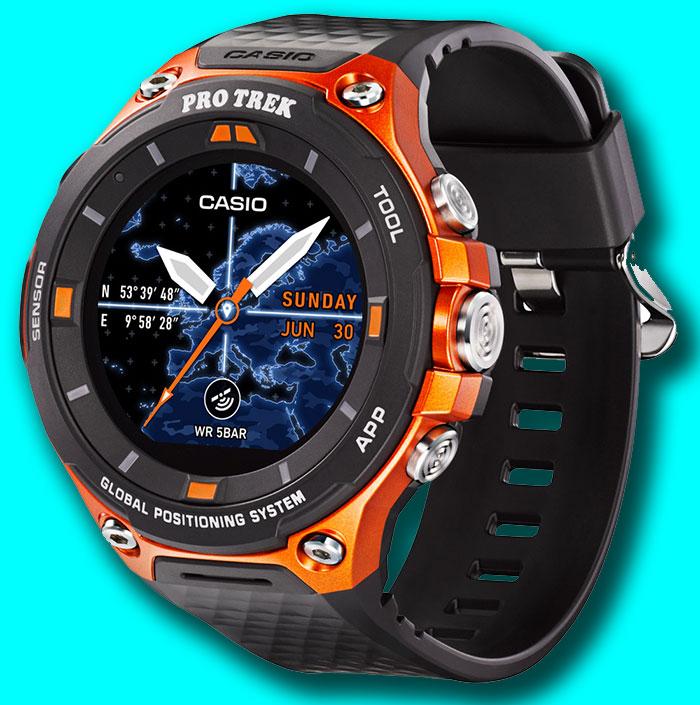This is Casio’s second attempt at a tough smartwatch. The big news this version is that it now packs on-board GPS – meaning you don’t have to have it paired with a smartphone to figure out where you’ve wandered off to. It also just happens to be the first smartwatch with Android 2.0 out the box – Google‘s software update that brings with it a load of new features.
As this watch is meant for the great outdoors, after strapping it to our wrist that’s exactly where we headed, making a b-line for the Abu Dhabi border near Al Qudra Oasis.

How does it look?
Casio’s first Smart Outdoor watch – the WSD-F10 – was chunky. So too is the follow-up, as that’s exactly what this watch needs to survive extreme weather. The bright orange and black casing sits 15.3mm above your wrist, with a diameter of 56.7mm. That means there’s little chance you’ll forget you’re wearing it.
In an outdoor setting, such as dune bashing around Al Qudra Lakes, it doesn’t look out of place. Not one bit. But back at the hotel afterwards, the F20 does look peculiar at the dinner table. The thing is huge, and not well-suited to more debonair activities.
Still, this comes from the same company that built the un-killable G-Shock. So it’s to be expected.

What does it do?
All that extra space houses the same barrage of sensors as the original. There’s an air-pressure sensor, accelerometer, pyrometer and magnetic compass inside. Each is accessibly by hitting the ‘tool’ button on the side, which cycles through all these settings.
Of course, the bigger news is that the F20 packs GPS. And it’s not just handy for knowing where you are in the desert. You can set trail markers and plot your course using the watch, and there’s even full-colour offline map downloads which are handy if you do want to leave your phone at home.
Using the built-in GPS is a bit fiddly at first. For starters, you need to be on the move for it to properly triangulate your position. You also need to be connected to Wi-Fi, which depending on the security settings and password of your router, can be tricky to input.
How long does it last?
Smartwatches live and die based on juice, and while the Casio comes with a decent-sized battery under the hood, it’s arsenal of sensors are thirsty. If you’re putting the F20 through its paces properly (paying attention to the sensors while using GPS, for example) you can expect less than 24-hours of use.
One full day of use is more or less bog standard for smartwatches of this ilk, but it’s a tad frustrating in this case. One of the reasons we’d imagine someone buying a GPS-enabled watch was to take it off the beaten path. It’s annoying that you can’t go camping in the desert for a night, unless you bring along one of those USB battery packs to juice it up overnight. Power is delivered via a magnetic charging socket, which is easy enough to attach.

Is it worth it?
There’s no doubt that the Casio Pro Trek Smart WSD-F20 is tougher than nails, and due to its built-in phone-less GPS capabilities, it automatically trumps most other smart watches designed for outdoor pursuits.
Android Wear is a perfectly functional smartwatch operating system, and Casio has done well to include its vast array of sensors and features in an easy-to-use format. It’s also more than capable at surviving the great outdoors, able to withstand anything the desert (or the sea, for that matter) might throw its way.
The only let-down then is its battery life. Which – while not a problem reserved solely for Casio (indeed, even Apple finds it hard to keep its watches powered on for more than 24-hours) – is frustrating, given this watch would, could and should be the ideal desert camping companion.



